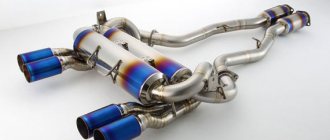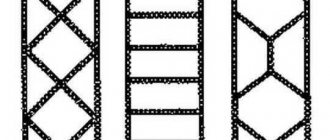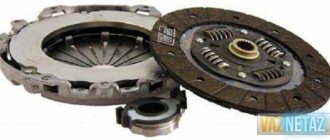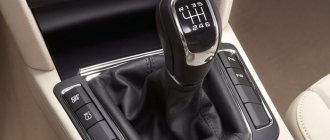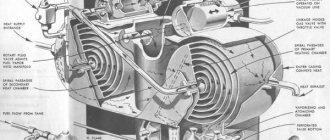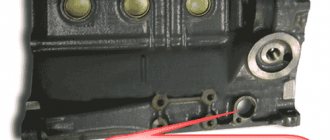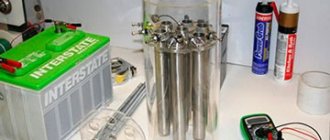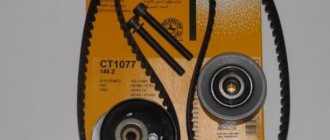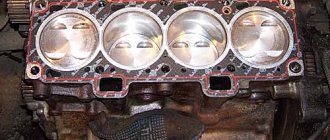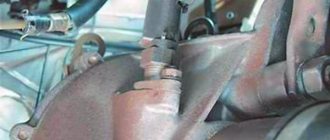- home
- Engine
- …
I often receive questions on my blog regarding the power unit, namely its boring. It is not entirely clear to beginners why this process occurs at all, what it gives and how many times it can be done. Personally, when I personally overhauled the engine, we had to sharpen the block and then “sleeve” it, all this happened on my MOSKVICH 2140. In modern realities, with a completely different level of lubricants and coolants, such repairs are VERY rare, now this is done more for tuning, but everything is in order...
First, a little definition
Block boring is the process of physically grooving the walls of the engine cylinders (on special machines) to restore the correct (almost ideal) geometric shape.
It is done during major engine repairs , or for tuning, mainly to increase power.
What is it done for?
As I wrote before (20-30 years ago), the main task was repairs. It is worth noting that the power unit and all its main parts experience constant loads, these are cylinders, pistons, rings, crankshaft, camshaft (shafts), valves, liners, etc.
The piston has especially strong loads; it rubs against the cylinder of the block, and this process is repeated hundreds - thousands of times in just one minute. This is where maximum wear occurs, the metal of the walls is ground off, and the block begins to lose its original round shape. If you exaggerate it, it becomes oval, not round. The fit of the pistons (namely its rings) to the walls begins to deteriorate, accordingly, the combustible mixture or exhaust gases begin to flow into the crankcase, and oil, on the contrary, into the working chamber - the power drops, the power unit begins to “eat oil”! Gray (bluish) smoke begins to fly from the muffler . These are the first bells.
To be fair, sometimes compression rings get stuck, compression will also drop and smoke will start pouring out, you will definitely need to open the engine and figure it out
Previously, there were no normal oils, they thickened wildly in winter, burned in summer, lubricity was low - engines had to be “overhauled” after 30 - 50,000 miles, and trucks only more often. In winter (oddly enough) the units overheated, all because, again, there were no normal antifreeze or antifreeze, they poured water that froze, forming traffic jams here and overheating was not far away, albeit local, even if not for long - BUT THIS WAS ENOUGH.
Now technology has stepped FAR forward. There are various semi-synthetic or synthetic formulations, not only of oils, but also of coolants. Therefore, now the engine runs for a long time! The resource from repairs has increased many times, if not tens of times.
Of course, after 250,000 (on average) kilometers there will still be repairs, but just think about the mileage! Medium-sized cities rarely get 15,000 people a year, so 250,000 will last about 15 years.
The first reason is, you guessed it repair , if possible (more on this below), the oval shape or scuffs inside the cylinder are removed by boring, more pistons are installed and the engine lives for many more thousands of kilometers.
The second reason is simply an increase in volume. Again, if the block (or rather its walls) allows, boring occurs, pistons of larger diameter are installed, they have a greater ability to suck in the air-fuel mixture. If you exaggerate a piston with a diameter of 79.8 mm, it will suck in much less than with a diameter of 82 mm. The fuel burns more, and accordingly the pressure of the ignited mixture on the piston is higher, so you get an increase in power. THEY MAKE MAINLY tuners for pumping up their “iron” horses.
Why do you need to bore the cylinder block?
The change in shape can only be determined using special measuring tools.
You need to understand that it is only in theory that the piston moves in the cylinder along an ideal trajectory. In fact, this is far from the case. And the greater the deviation from the ideal trajectory, the faster wear occurs on both the cylinders and pistons. The irregularity of the piston trajectory is associated with many factors, primarily of a structural nature. For example, this may be misalignment and non-perpendicularity of the position of the mating parts. In addition, premature wear is affected by too large dimensional tolerances, which allow the piston to move not only parallel to the cylinder axis, but also with a certain horizontal deviation.
And all this leads to the fact that the cylinder gradually loses its shape, and this may occur unevenly. And over time, the profile of the cylinder becomes not perfectly round, but elliptical.
In addition, the cylinder walls are exposed to high temperatures and combustion products are exposed, which gradually destroy the cylinder walls and at the same time the piston surface. And, it would seem, you can simply replace the piston, and everything will be fine. But this won't happen. If the geometry of the new piston is ideal, then the geometry of the cylinder is already broken, and no amount of replacing the piston without boring the cylinder block will help in this situation.
Cylinders must be bored if they are worn. But it should be understood that not all cylinders wear out, despite prolonged use. Some engines normally live out their life without any boring or repairs.
In order to determine the degree of cylinder wear, a system for assessing two cylinder dimensional parameters is used:
That is, if the parameters change by such values, repairs are already required. But the situation can be even worse when a defect appears in the upper part of the cylinder in the form of a step. It is this step that accelerates the breaking of not only the piston rings, but also the seats on the piston for the rings. Impacts occur, and very noticeable ones at that.
The engine begins to operate with strong vibrations. In addition, due to the resulting ellipse, the fit of the piston rings to the cylinder walls is disrupted. And this is fraught with a breakthrough of gases from the cylinder into the crankcase, compression in the engine is disrupted, and significant excess consumption of oil and fuel begins.
In the end, it may turn out that the rings simply fall apart from constant shock loads. In this case, the cylinder walls are damaged so that no boring can eliminate the resulting defect.
Boring of the cylinder block is needed in order to restore the geometric parameters of this part of the engine. But restoring the cylinder block concerns not only the geometric parameters of the cylinder themselves, but also the restoration of the normal position of the mating parts relative to each other.
Those. if you only achieve the normal geometry of the cylinder itself, this will not be enough to restore normal alignment and the normal location of all base surfaces. And if the base surfaces are not coaxial and parallel, then the cylinders will continue to break as the engine operates. And not just cylinders.
The stress and excess friction that occurs due to incorrect alignment will also affect other components of the piston group. Those. all moving parts involved in engine operation, included in the piston group, will experience additional bending, compression, etc. loads.
Aluminum and cast iron
Before telling you about the process itself, it’s worth mentioning that there are different materials for making blocks. These are cast iron (it appeared first) and aluminum. I will have a separate article about them, but today I will simply tell you which ones can be SHARPENED AND WHICH NOT!
Cast iron is an almost ideal option, cheap, reliable, durable. They last for a long time, and often give in to grooving. We remove the required size, install new repair pistons, and the engine is back in service. However, they also have significant disadvantages - weight (it is three times heavier than aluminum), heat dissipation (more passages and channels are needed to effectively cool it), and corrosion (the walls can rust from prolonged inactivity).
Aluminum is lightweight, has the best heat dissipation, and is not subject to corrosion. A big plus is its weight; now many manufacturers are chasing to reduce the weight of their cars; the aluminum version gives them greater savings, and therefore lower fuel consumption of the car. BUT this metal is soft and short-lived compared to cast iron. For better wear resistance, the inner walls are coated with a special coating with a high silicon content. THEN and only then can the motors operate for a sufficiently long time.
THAT'S WHY aluminum motors are often not sharpened; many craftsmen call them disposable! Because the durable top layer in the cylinders cannot be removed
How does the boring process work?
It is simpler than it seems at first glance. HOWEVER, you are unlikely to be able to do anything with your own hands. The engine is completely disassembled; BORING on the machine will not work. The block is removed and attached to the bed of a special machine, and it is fixed level!
If the boring process is carried out for repair, that is, there is a lot of wear (an ellipse has formed), then a series of measurements are made using micrometric pointer instruments - how much needs to be removed from the walls. AND IS THIS AT ALL POSSIBLE or do you immediately need to tune in to “GIZOVKA”.
Next, work is performed on a vertical boring machine. REMEMBER YOU NEED TO SEEK a highly qualified craftsman with good equipment, and not one that falls apart and cannot hold the EXACT size you need.
Next, the master stuffs - either a mirror inside the cylinder, or does honing (this is the finishing treatment of the walls to remove all risks and burrs, so that the walls and rings get used to each other faster), this is done first with a large abrasive, then with a fine one. Both methods have their fans, and which one to choose is up to everyone; the debate still does not subside.
And the final stage is assembly. Already for repair dimensions, spare parts are purchased, namely pistons, rings, all this is subsequently installed, connected to the crankshaft and the entire engine is assembled.
Everything is so simple when there is no need for sleeves, but here it’s not so simple.
Boring technological process
How to bore an engine? Many car enthusiasts have asked themselves this question. The technological process of boring is quite simple, but it requires care and understanding. Boring the internal parts of the engine, or rather the cylinders, is a precise task, so it is advisable to entrust such work to professionals who understand. Let's consider the main positions for boring internal combustion engines on analog and digital equipment.
Analog boring requires the constant intervention of a specialist, since it is he who determines what the size of the cylinders will be after the work is completed. Consider the sequence of actions:
- The cylinder block is installed on the frame so that the spindle is located in the center of the cylinder.
- A cutter is installed in the spindle, which will actually be used for boring.
- The machine turns on and the spindle begins to lower, while the cutting tool bores the cylinder.
- The remaining cylinders are bored in this same way.
- After the boring process, the engine will need to be honed, namely bringing the surface to a mirror state.
Sleeves as a method of repair
And in cast iron and aluminum blocks, there is such a thing as “Sleeve”, that is, special sleeves are installed - these are cylindrical (usually cast iron) hollow parts similar to a large piece of pipe.
They are pressed into the engine block under temperature and sit firmly in place. The main purpose is to make the motor stronger (in the case of the aluminum version), make the structure maintainable, and increase its service life. The sleeves can be made of high-strength alloy gray cast iron, as well as regular ones (it is worth noting that there are options with thin steel sleeves; this also exists, for example, ISUZU machines), there are also aluminum options, but they are not so common.
The big advantage is that when the liner wears out, it seems to take the entire blow upon itself. You simply pull it out (grind it out), install a repair one, or even one of the same size. Change the pistons and rings (most likely, repairs will be needed). And the engine runs normally again.
However, there are engines that are not “lined” from factories, both aluminum and cast iron. If we can bore a cast-iron block, and also “sleeve” it with a version of gray cast iron - install larger pistons (or the same ones) and roll on - because there is no difference in the thermal expansion of the metal. But aluminum, due to its complex manufacturing technology, is often not subject to this. A fair question arises - is it possible to put cartridges in it?
Aluminum block and sleeves
Guys, this is a VERY broad topic, perhaps I will write about it a little later. In the meantime, I’ll let you understand a few basic postulates.
Aluminum options are indeed often not recommended to be bored (although not all of them) and this is the point. First, let’s look at the manufacturing technology of modern blocks:
- When casting, thin-walled thin cast iron sleeves are installed at the factory, the wall thickness is 2 - 3 mm. Such options are called “dry with cast iron sleeves . Boring of this option is acceptable, and repair pistons and rings are produced for them. Installed on cars such as VOLVO, Land Rover, HONDA, SUBARU, NISSAN, SUZUKI and some others.
- All-aluminum monoblocks using SILUMAL (developed by MAHLE). There is a cast aluminum body here, but the walls from the inside are subjected to complex chemical-thermal treatment, after which a high concentration of silicon is formed on the walls; this material prevents the rings and pistons from quickly wearing out the walls and the resource increases to 150 - 200,000 km. The layer is quite thick and can also be bored out a LITTLE; for such engines, repair kits are available that increase the cylinder size by 0.5 - 1 mm. Such options are installed on many models of Mercedes, BMW, AUDI, PORSCHE and some other cars.
- NICASIL monoblock technology . Here, too, a durable coating of only a mixture of nickel and silicon carbide is applied to the surface of the cylinder walls. It is much thinner than its predecessor, and therefore cannot be repaired! The manufacturer has not provided repair capabilities and does not provide repair kits. Installed on some BMW models and others.
“Dry liners” and SILUMAL are quite repairable, that is, if your compression has dropped due to wear from high mileage, then you can easily remove 0.5 - 1 mm, install a repair piston group and continue riding. ALSO, for some SILUMAL variants, manufacturers produce ORIGINAL aluminum sleeves; they are needed when the bore is more than 1mm. True, their cost simply goes off scale, up to 200 EUROS per one, but there is an exceptional ratio of metals and the possibility of complete restoration (also in some cases you can buy one piece for one cylinder). The only EXCEPTION can be that the block wall is very badly damaged, to a depth greater than repair boring is possible. However, such blocks may not be saved by anything; fatal damage may occur, for example, the piston has turned.
NICASIL – it is virtually impossible to restore! That is, as the manufacturer assures, this is actually a disposable motor. As I wrote above, he does not have spare parts approved by the manufacturer. But in the country we live in, there are a lot of companies that make sleeves specifically for Nicasil, and cast iron with a small wall (2 - 3 mm), there are also craftsmen who can combine this whole thing! However, you need to remember about thermal expansion and various metals. Most likely, Uncle Vasya will not be able to do it efficiently in the garage. However, prices for new units, if you take top-end BMWs, can reach up to 5000 - 7000 EURO, force you to look for such masters.
This is such a large material, if it’s difficult to read, then watch the video version, it’s more detailed and simple.
I’ll end here, I think it was useful. SINCERELY YOUR AUTOBLOGGER
Similar news
- Carburetor or injector. Which is better and what is the difference between them?
- What is a TSI engine?
- Roll at “neutral” or downhill speed. How does this affect...
Add a comment Cancel reply
How is cylinder block boring done?
The operation to restore the required gap between the cylinder walls and the pistons is not that difficult.
It is enough to grind the cylinder to the required size on a boring machine, and the gap will appear by itself. Then all that remains is to install a new piston. Typically, a vertical boring machine is used for these operations to bore the cylinder block. And the correctness of boring depends on the condition of the equipment and the qualifications of the machine operator. However, this is not a complex technological operation.
But in order to remove the ellipse effect, you will have to tinker. Restoring the cylinder shape is the most difficult part of the process. The reason is that the deterioration of the internal surfaces of the cylinder can be very different at different places in the cylinder. Therefore, before starting boring, several measurements are taken using micrometric pointer instruments. And only after this a decision is made on how exactly the cylinder needs to be machined in order to achieve the desired surface geometry.
In addition to eliminating ellipse, boring the cylinder block aims to remove the taper of the cylinder. And this parameter should be no more than 0.01 mm. Along the entire length of the cylinder. Similar operations with such a minimal error can only be done on boring machines, whose grooving accuracy is even lower than 0.01 mm.
